|
|
|
Sort Order |
|
|
|
Items / Page
|
|
|
|
|
|
|
| Srl | Item |
| 1 |
ID:
188037
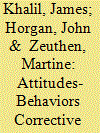

|
|
|
|
|
| Summary/Abstract |
Progress in understanding and responding to terrorism and violent extremism has continued to stall in part because we often fail to adequately conceptualize the problem. Perhaps most notably, much of our terminology (for instance, “radicalization”) and many variants of our existing models and analogies (including conveyor belts, staircases and pyramids) conflate sympathy for this violence with involvement in its creation. As its name suggests, the Attitudes-Behaviors Corrective (ABC) model seeks to overcome this issue by placing this key disconnect between attitudes and behaviors at its core. In this paper, we first present the key elements of our model, which include a graphic representation of this disconnect and a classification system of the drivers of violent extremism. The former enables us to track the trajectories of individuals in relation to both their attitudes and behaviors, while the latter helps ensure that we consider all potential explanations for these movements. We then adapt these elements to focus on exit from violence, applying the dual concepts of disengagement and deradicalization. Finally, we conclude with a section that aims to provide the research community and those tasked with preventing and countering violent extremism with practical benefits from the ABC model.
|
|
|
|
|
|
|
|
|
|
|
|
|
|
|
|
| 2 |
ID:
074608
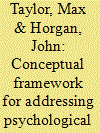

|
|
|
|
|
| Publication |
2006.
|
| Summary/Abstract |
A conceptual framework is presented for addressing psychological issues in the development of the terrorist. In particular, the authors suggest that viewing terrorism as a process may lead not only to better conceptual development in analyses of the terrorist, but may also lead to the development of more practical and efficient counterterrorism initiatives. Additionally, viewing terrorism in this way may finally lead to the formation of a clear and unambiguous position for psychology within an interdisciplinary approach to analyses of both terrorism and the terrorist.
|
|
|
|
|
|
|
|
|
|
|
|
|
|
|
|
| 3 |
ID:
148912


|
|
|
|
|
| Summary/Abstract |
Counterterrorism strategies involving the killing of terrorists are a prominently used but controversial practice. Proponents argue that such strategies are useful tools for reducing terrorist activity, while critics question their effectiveness. This article provides empirical insight into this strategy by conducting a series of negative binomial regression and Tobit estimations of the impact of killing Provisional Irish Republican Army (PIRA) terrorists as well as members of the Catholic community on counts of PIRA bombings and targeting activity in Northern Ireland for the period 1970–1998. We consider the impact of discriminate and indiscriminate killings (where only PIRA militants are killed versus those in which both militants and civilians are also killed) on subsequent PIRA improvised explosive device (IED) attacks. Our findings illustrate that while total and discriminate counterterrorism killings have little to no effect on PIRA IED attacks, indiscriminate counterterrorism killings increased PIRA bombings overall and prompted the Provisional IRA to specifically target civilians in IED events. We conclude by discussing the scholarly and policy implications of these findings.
|
|
|
|
|
|
|
|
|
|
|
|
|
|
|
|
| 4 |
ID:
075639
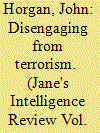

|
|
|
| 5 |
ID:
047419
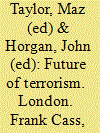

|
|
|
|
|
| Publication |
London, Frank Cass, 2000.
|
| Description |
234p.
|
| Standard Number |
0714680907
|
|
|
|
|
|
|
|
|
|
|
|
Copies: C:1/I:0,R:0,Q:0
Circulation
| Accession# | Call# | Current Location | Status | Policy | Location |
| 043325 | 303.625/TAY 043325 | Main | On Shelf | General | |
|
|
|
|
| 6 |
ID:
109789
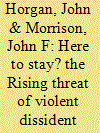

|
|
|
|
|
| Publication |
2011.
|
| Summary/Abstract |
Since the advent of the Good Friday peace agreement, violence associated with dissident Irish Republican groups continues to present major security challenges. While there has not been a tragedy on the scale of the 1998 Omagh bombing, the level of violent dissident Republican (VDR) activity has risen steadily in frequency since then, and in 2010 reached unprecedented levels. This article presents findings from the VDR Project at the International Center for the Study of Terrorism at Pennsylvania State University. The research is based on the extensive identification, collection, and analysis of open source material examining the nature and extent of VDR activity from 1997 to 2010. The project analyses data on VDR activity across this period as well as the individuals taking part in these violent events. The data suggests that while originally recruitment was predominantly southern based it is now more focused on Northern Ireland. Analysis of the data also indicates that the VDR leadership continues to recruit individuals with skill-sets to serve the movement's aims.
|
|
|
|
|
|
|
|
|
|
|
|
|
|
|
|
| 7 |
ID:
138074


|
|
|
|
|
| Summary/Abstract |
This paper presents an analysis of the Provisional Irish Republican Army’s (PIRA) brigade level behavior during the Northern Ireland Conflict (1970-1998) and identifies the organizational factors that impact a brigade’s lethality as measured via terrorist attacks. Key independent variables include levels of technical expertise, cadre age, counter-terrorism policies experienced, brigade size, and IED components and delivery methods. We find that technical expertise within a brigade allows for careful IED usage, which significantly minimizes civilian casualties (a specific strategic goal of PIRA) while increasing the ability to kill more high value targets with IEDs. Lethal counter-terrorism events also significantly affect a brigade’s likelihood of killing both civilians and high-value targets but in different ways. Killing PIRA members significantly decreases IED fatalities but also significantly decreases the possibility of zero civilian IED-related deaths in a given year. Killing innocent Catholics in a Brigade’s county significantly increases total and civilian IED fatalities. Together the results suggest the necessity to analyze dynamic situational variables that impact terrorist group behavior at the sub-unit level.
|
|
|
|
|
|
|
|
|
|
|
|
|
|
|
|
| 8 |
ID:
110005
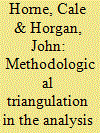

|
|
|
|
|
| Publication |
2012.
|
| Summary/Abstract |
The conceptualization of terrorist groups as networks is increasingly common to terrorism studies, although methods of analysis vary widely. Contrary to common understandings, the integration of computational and qualitative methods is possible even with limited (small-n) data. The triangulation of different methods can produce insights overlooked by the use of any single method and validate findings across methods. This article demonstrates some of the possibilities for integrating qualitative and quantitative methods for network analysis using Raffaello Pantucci's recent article, "The Tottenham Ayatollah and The Hook-Handed Cleric: An Examination of All Their Jihadi Children."
|
|
|
|
|
|
|
|
|
|
|
|
|
|
|
|
| 9 |
ID:
057389
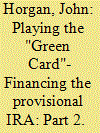

|
|
|
| 10 |
ID:
178911
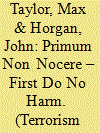

|
|
|
|
|
| Summary/Abstract |
This medical epithet seems to offer solid guidance for terrorism researchers and counterterrorism practitioners when thinking about the ethical implications of their work—to rephrase it, whatever you do, just don’t make it worse. It seems an appropriate guiding principle1 because although terrorism research remains even now largely dominated by theory (which, in pursuit of understanding, can seem removed from reality), the essence of terrorism lies in real-world practice—the actions of terrorists, and the concomitant actions of security, law enforcement and government agencies in response. And however we conceptualize these forces, they are in some measure reciprocally related, either reactively (in a terrorist event, or in responding to a terrorist event) or proactively (in preemptive initiatives). Such responses have consequences that impinge on individuals and society, and as such give rise to essentially moral questions about right and wrong, about harm and the consequences of behavior for others. The practitioner, researcher and terrorist therefore are all in some way participants in and subject to an appreciation of harm in a dynamic and complex moral decisional calculus. Of course, the idea of harm is itself complex; how much harm, and to whom or what? The researcher, society, government, employer, organization, family, tribe or even a concept like democracy, or the future? The idea of choice is also implied in that complex calculus; for whilst with hindsight a logic to choices can be discerned, in reality at the time of choice, there are often a number of possible alternative behavioral avenues to follow.
|
|
|
|
|
|
|
|
|
|
|
|
|
|
|
|
| 11 |
ID:
021731
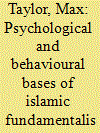

|
|
|
|
|
| Publication |
2001.
|
| Description |
37-71
|
|
|
|
|
|
|
|
|
|
|
|
|
|
|
|
| 12 |
ID:
064384
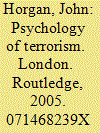

|
|
|
|
|
| Publication |
London, Routledge, 2005.
|
| Description |
xviii, 199p.
|
| Standard Number |
071468239X
|
|
|
|
|
|
|
|
|
|
|
|
Copies: C:1/I:0,R:0,Q:0
Circulation
| Accession# | Call# | Current Location | Status | Policy | Location |
| 049797 | 303.625/HOR 049797 | Main | On Shelf | General | |
|
|
|
|
| 13 |
ID:
169917


|
|
|
|
|
| Summary/Abstract |
This paper applies the distance-to-crime approach to the case of Improvised Explosive Device (IED) and shooting attacks conducted by the Provisional Irish Republican Army (PIRA) during the Northern Ireland conflict, 1970–1998. The aim is to (a) measure the typical ‘distance to crime’ (b) detect whether a distance-decay effect is noticeable and (c) investigate whether there is a discernible difference in the distance traveled depending upon individual offender characteristics or aspects of how the offence was committed. In particular, it highlights that many of the same dynamics that influence offender decision making within the volume crime world, also apply within the terrorism realm. Five findings stand out in particular. First, a distance decay effect is identifiable. Second, younger offenders travel significantly smaller distances. Third, complex attacks typically involve greater distances. Fourth, our results show the ability of leading decision-makers within PIRA to impact upon the day-to-day operations of the field operatives. Together the results reinforce the argument that when we focus on terrorism from a preventative angle, we should focus on their behaviors: what they do rather than remain preoccupied with concerns about who they are and/or what they might be like. Collectively the results also highlight the fact that for a finer-grained understanding of terrorist behavior we need to disaggregate on a number of levels: within the cadre of operatives, across terrorist attacks, across targets and within conflicts.
|
|
|
|
|
|
|
|
|
|
|
|
|
|
|
|
| 14 |
ID:
095296
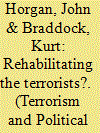

|
|
|
|
|
| Publication |
2010.
|
| Summary/Abstract |
Renewed interest on how and why terrorism ends has emerged in parallel with increased visibility of some new and innovative approaches to counterterrorism. These are collectively known, whether for good or bad, as "de-radicalization programs." However, and despite their popularity, data surrounding even the most basic of facts about these programs remains limited. This article presents an overview of the results of a one-year pilot study of select de-radicalization programs and investigates critical issues surrounding assessment of their effectiveness and outcomes. We argue that Multi Attribute Utility Technology (MAUT) may offer promise for future empirical assessment of what we prefer to designate "terrorism risk reduction initiatives." Perhaps less obviously, and until more data surrounding the efficacy of such initiatives becomes available, MAUT may also provide a conceptual basis for planning, evaluating, and guiding the development of future such initiatives and may have the unanticipated consequence of facilitating progress by encouraging greater exploration of efforts to change behavior from other contexts.
|
|
|
|
|
|
|
|
|
|
|
|
|
|
|
|
| 15 |
ID:
148917
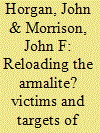

|
|
|
|
|
| Summary/Abstract |
The centenary of the 1916 Rising marks a time of peaceful commemoration, across the island of Ireland. However, several violent dissident republican groups wish to seize it as an opportunity to re-organise in an attempt to bolster and legitimise their sustained paramilitary campaign. This study seeks to provide a greater understanding of how this paramilitary activity has manifested from 2007 to mid-2015. We do this by assessing target selection, through analysis of the Violent Dissident Republican (VDR) events database. The data suggest that civilian targets are the most regularly attacked. However, when exclusively analysing targets of detonated explosives, the data show that police, security personnel, and their infrastructure are more consistently targeted. The target selected can and does have an effect on attack method. These findings can both assist in protecting the potential targets of VDR attacks and contribute to the development of a strong nationalised, and localised, counter VDR narrative.
|
|
|
|
|
|
|
|
|
|
|
|
|
|
|
|
| 16 |
ID:
108747
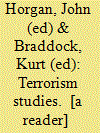

|
|
|
|
|
| Publication |
Oxon, Routledge, 2012.
|
| Description |
xxiii, 504p.
|
| Standard Number |
9780415455053
|
|
|
|
|
|
|
|
|
|
|
|
Copies: C:1/I:0,R:0,Q:0
Circulation
| Accession# | Call# | Current Location | Status | Policy | Location |
| 056355 | 363.325/HOR 056355 | Main | On Shelf | General | |
|
|
|
|
| 17 |
ID:
093653
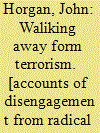

|
|
|
|
|
| Publication |
London, Routledge, 2009.
|
| Description |
xxv, 186p.
|
| Standard Number |
9780415439442
|
|
|
|
|
|
|
|
|
|
|
|
Copies: C:1/I:0,R:0,Q:0
Circulation
| Accession# | Call# | Current Location | Status | Policy | Location |
| 054701 | 363.325/HOR 054701 | Main | On Shelf | General | |
|
|
|
|
| 18 |
ID:
121903
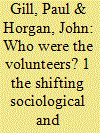

|
|
|
|
|
| Publication |
2013.
|
| Summary/Abstract |
This article presents an empirical analysis of a unique dataset of 1240 former members of the Provisional Irish Republican Army (PIRA). We highlight the shifting sociological and operational profile of PIRA's cadre, and highlight these dynamics in conjunction with primary PIRA documents and secondary interview sources. The effect of these changes in terms of the scale and intensity of PIRA violence is also considered. Although this is primarily a study of a disbanded violent organization, it contains broad policy implications beyond the contemporary violence of dissident movements in both Northern Ireland and the Republic of Ireland. We conclude with a consideration of how a shifting sociological profile impacts upon group effectiveness, resilience, homogeneity, and the turn toward peaceful means of contention.
|
|
|
|
|
|
|
|
|
|
|
|
|
|
|
|
|
|
|
|
|